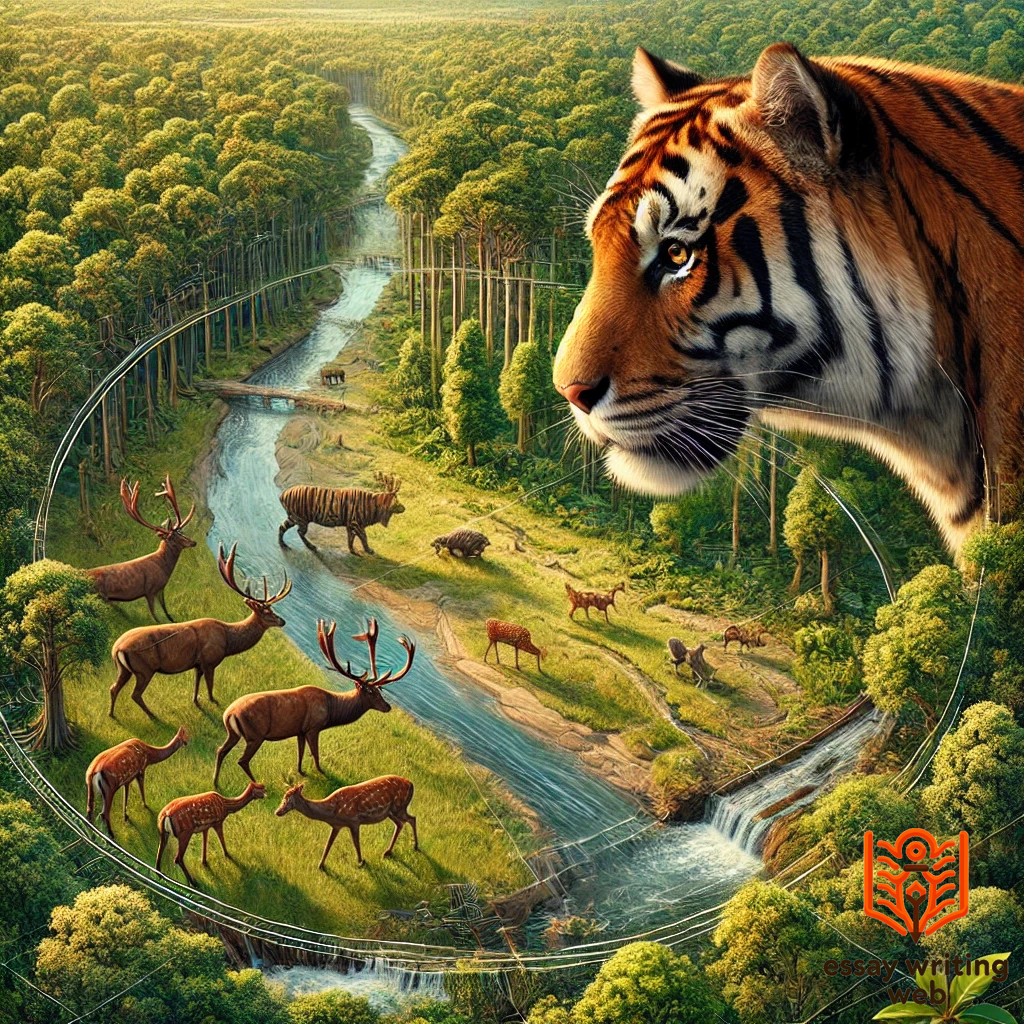 Essay Writing Web
Essay Writing Web

 14-09-2024
14-09-2024
 www.essaywritingweb.com
www.essaywritingweb.com
The tiger, one of the most iconic and majestic creatures in the animal kingdom, stands as a symbol of strength, power, and beauty. As the largest member of the cat family, tigers command a dominant presence in the wild, known for their distinctive orange coats marked with bold black stripes. These stripes not only give each tiger a unique identity but also serve as an effective camouflage in their natural habitats. Found primarily in Asia, tigers inhabit diverse ecosystems ranging from tropical rainforests and grasslands to mangroves and mountainous regions.
Historically, tigers have held a significant place in human culture, especially in Asia, where they are often seen as symbols of bravery and protection. Depicted in folklore, mythology, and traditional art, the tiger has long been admired for its grace and power. It has also been recognized as a national symbol of countries like India, highlighting its cultural importance.
However, the survival of tigers is threatened due to habitat loss, poaching, and human-wildlife conflict. Once spread across much of Asia, their numbers have drastically declined, making them an endangered species. Conservation efforts, such as the establishment of protected areas and anti-poaching laws, have been initiated to save these magnificent animals from extinction. Programs like "Project Tiger" in India aim to restore tiger populations and preserve their natural habitats.
Tigers play a vital role in maintaining the balance of their ecosystems as apex predators. They help regulate prey populations and contribute to the health of the forests they inhabit. The ongoing efforts to protect tigers are essential, not only to safeguard a species but also to preserve the biodiversity and ecological harmony of the regions they call home.
The tiger is renowned for its striking physical appearance, which makes it one of the most recognizable animals in the world. Its muscular build, powerful limbs, and agile movements allow it to dominate as an apex predator in the wild. Tigers typically have a rich orange or reddish-brown coat covered with bold black stripes that vary in pattern, making each tiger unique. These stripes serve not only as a form of camouflage, blending the animal into the forest and grassland environments, but also help in identifying individual tigers.
A tiger’s body is long and sleek, with a tail that aids in balance during hunting or navigating uneven terrain. Their large paws, equipped with retractable claws, assist in gripping prey, while their sharp, strong teeth are designed for tearing meat. Tigers possess excellent night vision, allowing them to hunt in low light conditions, and their keen sense of hearing and smell further enhance their hunting capabilities.
Males are generally larger than females, with male Bengal tigers weighing between 220 to 300 kilograms and measuring up to 3 meters in length, including the tail. This impressive physique enables tigers to take down large prey, from deer to wild boars, making them one of nature’s most formidable predators.

Tigers, though belonging to the same species, vary significantly depending on their subspecies. The Bengal tiger, native to India, Bangladesh, Bhutan, and Nepal, is the most common and recognizable subspecies. It is known for its vibrant orange coat with bold black stripes and can weigh up to 220 kilograms. Bengal tigers inhabit diverse habitats, from grasslands to mangroves, and are known for their adaptability.

The Siberian tiger, also known as the Amur tiger, is the largest subspecies. Found in the Russian Far East and parts of China, this tiger has a paler, thicker coat to help it survive in colder climates. It also has fewer and wider stripes compared to its Bengal counterpart, and it can weigh up to 300 kilograms.

Sumatran tigers, the smallest subspecies, are native to the Indonesian island of Sumatra. These tigers have darker fur with denser stripes and are more compact in size, weighing between 100-140 kilograms. Their smaller size allows them to navigate the dense rainforests of Sumatra more easily.

Each subspecies has evolved distinct physical characteristics and behaviors to adapt to its specific environment, showcasing the diversity within the tiger species while underscoring the importance of preserving all tiger populations.
Tigers, being one of the most adaptable and versatile big cats, inhabit a wide range of environments across Asia. Their habitats extend from the tropical rainforests of Southeast Asia to the cold, snowy forests of Siberia. Each subspecies of tiger is uniquely adapted to survive in its particular environment, demonstrating their remarkable ability to thrive in different ecosystems.
Bengal tigers, for instance, are found in a variety of landscapes, including the mangrove forests of the Sundarbans, grasslands, and dense tropical and subtropical forests. Their ability to swim makes them especially suited to wetland areas. Siberian tigers, on the other hand, reside in the taiga and temperate forests of Russia and northeastern China. These forests are harsh, with long, cold winters and heavy snowfall, and the tigers have developed thicker fur and a layer of fat to cope with the extreme climate.
Sumatran tigers are primarily found in the dense rainforests of the Indonesian island of Sumatra. These forests are thick with vegetation, making it essential for these tigers to be smaller and more agile to move through the underbrush. This habitat is rich in biodiversity, but due to deforestation, the Sumatran tiger’s range has diminished.
Tigers need large territories to hunt and roam freely, as they are solitary and territorial animals. Unfortunately, human activities such as deforestation, agriculture, and urbanization have severely reduced their natural habitats, posing a significant threat to their survival. Conservation efforts, including the creation of protected areas, are crucial in preserving the natural habitats that tigers depend on.

Tigers are apex predators with a carnivorous diet, relying heavily on their hunting skills to survive in the wild. Their diet consists primarily of large ungulates such as deer, wild boar, and buffalo, though they are known to hunt smaller prey like birds, monkeys, and fish when larger prey is scarce. Tigers also occasionally prey on livestock, which leads to conflict with humans in areas where their natural food sources have dwindled due to habitat loss.
Tigers are solitary hunters, relying on their strength, stealth, and patience to catch prey. Their striped fur acts as natural camouflage, blending with the surrounding foliage and allowing them to approach their prey unnoticed. Tigers typically hunt at dawn or dusk, taking advantage of the low light and their excellent night vision. When stalking prey, a tiger moves quietly and cautiously, closing the distance as much as possible before launching a powerful, sudden attack.
A tiger’s preferred method of killing is to target the neck or throat of its prey, using its strong jaws and sharp canine teeth to deliver a fatal bite. Once the prey is subdued, the tiger will drag it to a secluded spot before feeding. Tigers can consume up to 40 kilograms of meat in one sitting, and they often hide leftover carcasses to return to later.
Their impressive hunting techniques and ability to take down large prey make tigers formidable predators, but they require vast territories and abundant prey to thrive, making conservation efforts essential for their survival.

Tigers are known for their solitary and territorial behavior, unlike many other big cats that may live or hunt in groups. Each tiger maintains its own territory, which can range from 20 to 100 square kilometers, depending on the availability of prey and environmental conditions. Male tigers tend to have larger territories than females, often overlapping with the ranges of several females. The size of a tiger's territory is crucial for its survival, as it provides sufficient space for hunting and avoiding competition.
Tigers mark their territories by scent-marking with urine, scratching trees, and leaving visual signs along boundaries. These behaviors help establish dominance and minimize conflicts with other tigers. While generally solitary, tigers do occasionally interact, especially during mating season. Males and females come together briefly to mate, but after that, the female is left to raise the cubs alone.
Female tigers are highly protective of their cubs, typically giving birth to a litter of two to four cubs. The mother raises and teaches her cubs essential survival skills, such as hunting, until they are independent, which usually occurs around 18 to 24 months of age.
Tigers communicate using vocalizations like roars, growls, and chuffing, as well as through body language and scent markings. Despite their solitary nature, tigers have a complex social structure that helps them avoid unnecessary conflict and ensure their survival. This balance of independence and communication reflects the tiger's adaptability and intelligence in the wild.

Tigers play a critical role in maintaining the health and balance of the ecosystems they inhabit. As apex predators, they are at the top of the food chain and regulate the populations of herbivores, such as deer, wild boar, and other large prey animals. By controlling herbivore populations, tigers help prevent overgrazing and the depletion of vegetation, which in turn maintains the balance of the forest ecosystem.
This regulation of prey species is essential for sustaining biodiversity in these environments. A well-balanced ecosystem supports a variety of plant and animal species, each contributing to the overall health and resilience of the environment. When tiger populations decline, herbivore numbers can increase unchecked, leading to overgrazing, habitat degradation, and a decrease in biodiversity.
Tigers also indirectly support the livelihoods of human communities. Many ecosystems where tigers live, such as forests and grasslands, provide vital resources for local populations, including water, wood, and medicinal plants. By preserving tiger habitats, we help protect these essential resources, which contribute to human well-being and economic development.
Furthermore, tigers are a symbol of national pride and cultural heritage in many countries, particularly in Asia. They attract ecotourism, generating income for local communities and supporting conservation efforts. The survival of tigers is, therefore, crucial not only for maintaining ecological balance but also for preserving cultural heritage and supporting sustainable livelihoods for people living in tiger habitats.

There are six main subspecies of tigers that are currently recognized, each adapted to its specific habitat. These subspecies are unique in terms of size, appearance, and distribution. Here’s an overview of the different types of tigers:






Tigers, as an endangered species, have been the focus of various conservation efforts led by governments and non-governmental organizations (NGOs) worldwide. In India, where a significant population of tigers exists, the government launched Project Tiger in 1973, one of the most successful conservation programs aimed at protecting this majestic species. This initiative established numerous tiger reserves across the country, offering tigers a safe habitat where they are protected from poaching and habitat destruction. Over the decades, Project Tiger has played a vital role in increasing the population of Bengal tigers, though challenges remain.
Project Tiger focuses on habitat management, scientific research, and community involvement. It helps secure funding for the creation and maintenance of tiger reserves, such as Ranthambore and Jim Corbett, and works to mitigate human-tiger conflicts. Through strict anti-poaching laws and patrolling, the program has helped reduce illegal hunting activities, though enforcement is still a key concern.
In addition to governmental initiatives, several NGOs have been instrumental in tiger conservation. Organizations like the World Wildlife Fund (WWF) and Wildlife Protection Society of India (WPSI) have contributed significantly by raising awareness, conducting research, and working on the ground to protect tiger habitats. WWF’s TX2 program, for example, aims to double the global tiger population by 2022 by working with governments, scientists, and communities.
These combined efforts emphasize the importance of collaboration between governments and NGOs in the conservation of tigers, ensuring that future generations can witness these magnificent.

Zoos and breeding programs have played a significant role in tiger conservation, particularly as wild tiger populations face critical threats from habitat loss, poaching, and human-wildlife conflict. These initiatives aim to ensure the survival of tigers by creating safe, controlled environments where they can breed, thereby maintaining genetic diversity and bolstering dwindling populations.
Zoos often collaborate on international breeding programs such as the Species Survival Plan (SSP), which involves breeding tigers in captivity with the goal of preserving healthy, genetically diverse populations. These programs work to prevent inbreeding and ensure the long-term viability of the species, offering a safeguard against extinction in the wild. In addition, zoos act as hubs for public education, raising awareness about the plight of tigers and the importance of conservation efforts.
Furthermore, breeding programs sometimes serve as a foundation for reintroduction efforts, though such attempts are challenging due to the difficulty of re-adapting tigers to the wild. Nevertheless, captive-bred tigers have been successfully released into protected reserves, demonstrating the potential of these programs.
While zoos alone cannot solve the broader issues facing wild tigers, their contributions to breeding, research, and awareness are valuable tools in the fight to preserve these majestic animals for future generations.

The tiger holds a prestigious place as a national symbol in several countries, notably India and Bangladesh, where it represents strength, power, and cultural heritage. In these nations, the tiger not only embodies the spirit of resilience and courage but also plays a vital role in the identity of the people and the preservation of their natural heritage.
In India, the Bengal tiger is the national animal, symbolizing the country's rich wildlife and commitment to conservation. Known for its majestic beauty and strength, the Bengal tiger has long been a part of Indian culture, appearing in ancient folklore, literature, and art. The tiger's status as a national symbol also highlights India's ongoing efforts to protect and preserve its wildlife through initiatives like Project Tiger, which focuses on tiger conservation across the country.
Similarly, in Bangladesh, the Royal Bengal tiger is the national animal, representing the country's natural wealth and resilience. Found in the Sundarbans, the largest mangrove forest in the world, the tiger is a source of national pride. The Sundarbans itself is a UNESCO World Heritage Site, further emphasizing the tiger's importance to both the environment and the country's identity.
As a national symbol, the tiger reminds these nations of the importance of wildlife conservation and their cultural connection to one of the most iconic animals on Earth.
